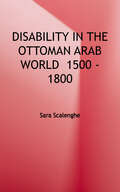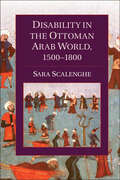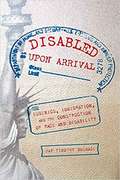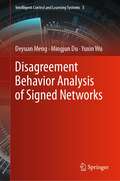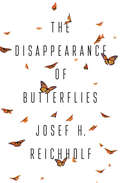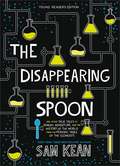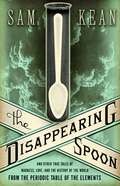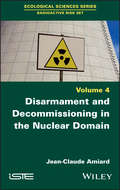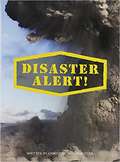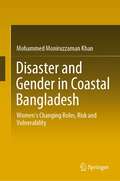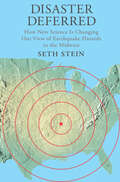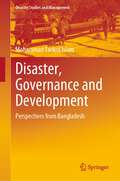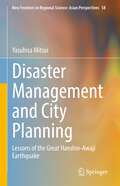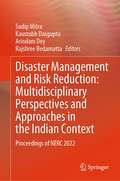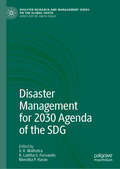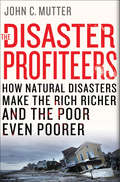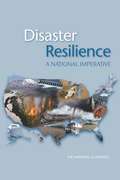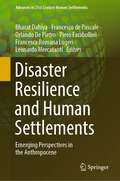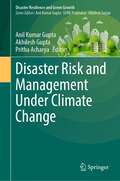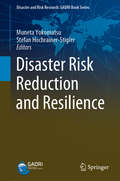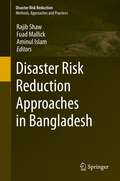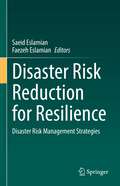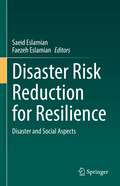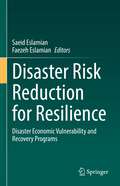- Table View
- List View
Disability in the Ottoman Arab World, 1500-1800 (Cambridge Studies in Islamic Civilization Ser.)
by Sara ScalenghePhysical, sensory, and mental impairments can influence an individual's status in society as much as the more familiar categories of gender, class, religion, race, and ethnicity. This was especially true of the early modern Arab Ottoman world, where being judged able or disabled impacted every aspect of a person's life, including performance of religious ritual, marriage, job opportunities, and the ability to buy and sell property. Sara Scalenghe's book is the first on the history of both physical and mental disabilities in the Middle East and North Africa, and the first to examine disability in the non-Western world before the nineteenth century. Unlike previous scholarly works that examine disability as discussed in religious texts such as the Qur'an and the Hadith, this study focuses on representations and classifications of disability and impairment across a wide range of biographical, legal, medical, and divinatory primary sources.
Disability in the Ottoman Arab World, 1500-1800 (Cambridge Studies in Islamic Civilization)
by Sara ScalenghePhysical, sensory, and mental impairments can influence an individual's status in society as much as the more familiar categories of gender, class, religion, race, and ethnicity. This was especially true of the early modern Arab Ottoman world, where being judged able or disabled impacted every aspect of a person's life, including performance of religious ritual, marriage, job opportunities, and the ability to buy and sell property. Sara Scalenghe's book is the first on the history of both physical and mental disabilities in the Middle East and North Africa, and the first to examine disability in the non-Western world before the nineteenth century. Unlike previous scholarly works that examine disability as discussed in religious texts such as the Qur'an and the Hadith, this study focuses on representations and classifications of disability and impairment across a wide range of biographical, legal, medical, and divinatory primary sources.
Disabled Upon Arrival: Eugenics, Immigration, And The Construction Of Race And Disability
by Jay Timothy DolmageIn North America, immigration has never been about immigration. That was true in the early twentieth century when anti-immigrant rhetoric led to draconian crackdowns on the movement of bodies, and it is true today as new measures seek to construct migrants as dangerous and undesirable. This premise forms the crux of Jay Timothy Dolmage’s new book Disabled Upon Arrival: Eugenics, Immigration, and the Construction of Race and Disability, a compelling examination of the spaces, technologies, and discourses of immigration restriction during the peak period of North American immigration in the early twentieth century. Through careful archival research and consideration of the larger ideologies of racialization and xenophobia, Disabled Upon Arrival links anti-immigration rhetoric to eugenics—the flawed “science” of controlling human population based on racist and ableist ideas about bodily values. Dolmage casts an enlightening perspective on immigration restriction, showing how eugenic ideas about the value of bodies have never really gone away and revealing how such ideas and attitudes continue to cast groups and individuals as disabled upon arrival.
Disagreement Behavior Analysis of Signed Networks (Intelligent Control and Learning Systems #5)
by Deyuan Meng Mingjun Du Yuxin WuThis book investigates the disagreement behavior analysis problems for signed networks in the presence of both cooperative and antagonistic interactions among agents. Owing to the existing antagonistic interactions, signed networks exhibit a variety of disagreement behaviors subject to different topology conditions, especially in comparison with commonly considered unsigned networks involving only cooperative interactions among agents. Since signed networks are generally adopted to describe the dynamics of some practical network systems, they have attracted much attention in many areas, such as biology, sociology, economics, and politics. By focusing on agents with the first-order linear dynamics, the book establishes the systematic behavior analysis frameworks for signed networks, under which diverse disagreement behaviors have been disclosed, including both convergence and fluctuation behaviors, regardless of static or dynamic network topologies. In particular, a class of dynamic signed networks has been introduced, together with the associated dynamic distributed controller design and disagreement behavior analysis of agents. This book is intended for undergraduate and graduate students, engineers, and researchers who are interested in control of network systems, multi-agent systems, social networks, and so on.
The Disappearance of Butterflies
by Josef H. ReichholfIn the last fifty years our butterfly populations have declined by more than eighty per cent and butterflies are now facing the very real prospect of extinction. It is hard to remember the time when fields and meadows were full of these beautiful, delicate creatures – today we rarely catch a glimpse of the Wild Cherry Sphinx moths, Duke of Burgundy or the even once common Small Tortoiseshell butterflies. The High Brown Fritillary butterfly and the Stout Dart Moth have virtually disappeared. The eminent entomologist and award-winning author Josef H. Reichholf began studying butterflies in the late 1950s. He brings a lifetime of scientific experience and expertise to bear on one of the great environmental catastrophes of our time. He takes us on a journey into the wonderful world of butterflies - from the small nymphs that emerge from lakes in air bubbles to the trusting purple emperors drunk on toad poison - and immerses us in a world that we are in danger of losing forever. Step by step he explains the science behind this impending ecological disaster, and shows how it is linked to pesticides, over-fertilization and the intensive farming practices of the agribusiness. His book is a passionate plea for biodiversity and the protection of butterflies.
The Disappearing Spoon: And Other True Tales of Rivalry, Adventure, and the History of the World from the Periodic Table of the Elements (Young Readers Edition)
by Sam KeanA young readers edition of the New York Times bestseller The Disappearing Spoon, chronicling the extraordinary stories behind one of the greatest scientific tools in existence: the periodic table.Why did Gandhi hate iodine (I, 53)? How did radium (Ra, 88) nearly ruin Marie Curie's reputation? And why did tellurium (Te, 52) lead to the most bizarre gold rush in history?The periodic table is a crowning scientific achievement, but it's also a treasure trove of adventure, greed, betrayal, and obsession. The fascinating tales in The Disappearing Spoon follow elements on the table as they play out their parts in human history, finance, mythology, conflict, the arts, medicine, and the lives of the (frequently) mad scientists who discovered them. Adapted for a middle grade audience, the young readers edition of The Disappearing Spoon offers the material in a simple, easy-to-follow format, with approximately 20 line drawings and sidebars throughout. Students, teachers, and burgeoning science buffs will love learning about the history behind the chemistry.
The Disappearing Spoon: And Other True Tales of Madness, Love, and the History of the World from the Periodic Table of the Elements
by Sam KeanFrom New York Times bestselling author Sam Kean comes incredible stories of science, history, finance, mythology, the arts, medicine, and more, as told by the Periodic Table. Why did Gandhi hate iodine (I, 53)? How did radium (Ra, 88) nearly ruin Marie Curie's reputation? And why is gallium (Ga, 31) the go-to element for laboratory pranksters?*The Periodic Table is a crowning scientific achievement, but it's also a treasure trove of adventure, betrayal, and obsession. These fascinating tales follow every element on the table as they play out their parts in human history, and in the lives of the (frequently) mad scientists who discovered them. THE DISAPPEARING SPOON masterfully fuses science with the classic lore of invention, investigation, and discovery--from the Big Bang through the end of time. *Though solid at room temperature, gallium is a moldable metal that melts at 84 degrees Fahrenheit. A classic science prank is to mold gallium spoons, serve them with tea, and watch guests recoil as their utensils disappear.
Disarmament and Decommissioning in the Nuclear Domain
by Jean-Claude AmiardFollowing the acquisition of the atomic bomb by five states, the United Nations began drafting several treaties to limit nuclear proliferation. These efforts failed, as four more states also acquired nuclear weapons. In a similar vein, an attempt to limit atomic weapons - primarily within the two superpowers - was initiated.While the number of weapons has decreased, the new bombs now being manufactured are more powerful and more precise, negating any reduction in numbers. In the field of civil nuclear use, all nuclear facilities (reactors, factories, etc.) have a limited lifespan. Once a plant is permanently shut down, these facilities must be decommissioned and dismantled.These operations are difficult, time-consuming and costly. In addition, decommissioning generates large volumes of radioactive waste of various categories, including long-lived and high-activity waste. Risks to the environment and to health are not negligible during decommissioning. The International Atomic Energy Agency (IAEA) and the Nuclear Energy Agency (NEA) of the Organisation for Economic Co-operation and Development (OECD) have produced numerous publications with recommendations. Each state has its own decommissioning strategy (immediate or delayed) and final plan for the site - whether it be returning it to greenfield status or obtaining a nuclear site license with centuries-long monitoring.
Disaster and Gender in Coastal Bangladesh: Women’s Changing Roles, Risk and Vulnerability
by Mohammed Moniruzzaman KhanThis volume explores the discourse of disaster and women in the existing social settings and state disaster-related affairs in coastal Bangladesh. It covers various issues ranging from disproportionate vulnerability, coping and adaptation mechanisms for women, limitations for promoting participation and involvement of women in the decision-making process both in family and community and changes in the role and responsibilities of women for reducing disaster risk and vulnerability. It contributes to the deconstruction of gender-based identity by addressing women's changing practices and roles in the coastal area in terms of the involvement of women with the development process, earning/income generation activities, decision-making process, access and entitlements to resources. This book presents the most current and inclusive circumstances of disaster and women of the coastal area in Bangladesh. The insights obtained through the eyes of a sociologist from a holistic perspective make this book different and unique. The book is of interest to researchers, academics, policymakers and professionals engaged in the social understanding of disaster studies, as well as to researchers and practitioners in interdisciplinary domains, including sociology, gender studies, social work, environmental studies, and development studies.
Disaster Deferred: A New View of Earthquake Hazards in the New Madrid Seismic Zone
by Seth SteinIn the winter of 1811-12, a series of large earthquakes in the New Madrid seismic zone-often incorrectly described as the biggest ever to hit the United States-shook the Midwest. Today the federal government ranks the hazard in the Midwest as high as California's and is pressuring communities to undertake expensive preparations for disaster. Coinciding with the two-hundredth anniversary of the New Madrid earthquakes, Disaster Deferred revisits these earthquakes, the legends that have grown around them, and the predictions of doom that have followed in their wake. Seth Stein clearly explains the techniques seismologists use to study Midwestern quakes and estimate their danger. Detailing how limited scientific knowledge, bureaucratic instincts, and the media's love of a good story have exaggerated these hazards, Stein calmly debunks the hype surrounding such predictions and encourages the formulation of more sensible, less costly policy. Powered by insider knowledge and an engaging style, Disaster Deferred shows how new geological ideas and data, including those from the Global Positioning System, are painting a very different-and much less frightening-picture of the future.
Disaster Deferred: How New Science Is Changing Our View of Earthquake Hazards in the Midwest
by Seth SteinA geologist takes readers inside contemporary earthquake research to offer a new account of the Midwest&’s legendary New Madrid fault—&“an exceptional read&” (Choice). In the winter of 1811-12, a series of large earthquakes in the New Madrid seismic zone shook the Midwest. These historic geological events are often incorrectly described as the biggest ever to hit the United States. Today the federal government ranks the earthquake hazard in the Midwest as high as California's and is pressuring communities to undertake expensive preparations for disaster. In Disaster Deferred, geologist Seth Stein revisits these earthquakes, the legends that have grown around them, and the predictions of doom that have followed in their wake. He details how limited scientific knowledge, bureaucratic instincts, and the media's love of a good story have exaggerated these hazards. Debunking the hype, Stein explains how contemporary seismological techniques—including the use of GPS—painting a very different-and much less frightening-picture of the future. Using new geological ideas and data, he calls for a more sensible, less costly policy. &“An essential book for policy makers, economists, and notably educators.&”—Choice
Disaster, Governance and Development: Perspectives from Bangladesh (Disaster Studies and Management)
by Mohammad Tarikul IslamThis book unveils the nexus between disaster, governance and development with a particular focus on Bangladesh and examines the legislative and institutional aspects in mainstreaming disaster risk reduction into development planning. With the help of rich content analysis interpreting disaster management history of the country, it looks at the challenges associated with disaster management in the context of Bangladesh. The book highlights the most reasonable strategy on how to accelerate a paradigm shift from relief culture to DRR culture. It also assesses the viewpoint of how political economy influences governance and institutional strengthening, thus identifying obstructions and opportunities for mainstreaming disaster management into development. The book also lays emphasis on collaboration between public sector and private sector for the expansion of disaster risk reduction programme. It shows how multilevel governance works for professionalizing disaster management and throws light on policy frameworks developed. This book is a tremendous resource for scholars, practitioners and researchers of disaster management, environmental studies, development agencies, political science, public policy, development studies, governance, regional development, South Asian studies and local government, particularly those interested in disaster, governance and sustainable development.
Disaster Management and City Planning: Lessons of the Great Hanshin-Awaji Earthquake (New Frontiers in Regional Science: Asian Perspectives #58)
by Yasuhisa MitsuiThis book first provides a comprehensive guideline for future disaster-resistant city planning in large cities in disaster-prone countries such as Japan. It is a compilation of knowledge and know-how obtained through the author’s work in the national government for one and half years in the Earthquake Reconstruction Headquarters, right after the Great Hanshin-Awaji Earthquake on 17 January 1995. The author has carefully examined the various ad hoc measures taken just after the earthquake, which were criticized because they did not work as well as expected. Additionally, he has examined the later revisions in disaster and risk management systems made at the levels of local and national governments through experience in the Hanshin-Awaji Earthquake, to which the author had long been committed. The author argues that the rescue activities, rehabilitation, and reconstruction plans for disaster countermeasures implemented once a disaster has occurred and the city planning established in ordinary times should be extremely tightly connected with each other. City planning that subsumes rescue activities, rehabilitation, and reconstruction plans against what ought to have happened would critically improve the capability of crisis management and, consequently, protect life and property once a disaster has occurred. Such city planning eventually creates disaster-resistant cities. This book assumes readers to be graduate students who study city planning. It is also beneficial for practitioners and policy makers who are in charge of the construction of disaster-resistant cities at the national and local levels of governments, especially in disaster-prone countries.
Disaster Management and Risk Reduction: Proceedings of NERC 2022
by Sudip Mitra Kaustubh Dasgupta Arindam Dey Rajshree BedamattaThis book presents select proceedings of North-East Research Conclave (NERC 2022) that will help pave way toward disaster risk reduction through a holistic and multidisciplinary approach. The book discusses topics, such as rapid pace of climate change, its deleterious effects on nature and natural systems, human interventions in altering the natural geographical and geological systems, widespread urbanization, recurrent unwarranted rainfall and cloud bursts, unprecedented flooding, catastrophic landslides, dam breakages, glacial outbursts, snow avalanches, seismicity and its impacts, liquefaction, and wreaking environmental pollution leading to unimaginable toll on lives, property and economy. The book also discusses approaches to address such issues and frame a refined path towards a sustainable future, such as a three-fold approach like – Awareness, Inferences and Implementations. For this approach, it is ardently necessary to understand the core reasoning behind the disasters, their impact on the socio-economic contexts, and the ways to mitigate them. The book can be a valuable reference for beginners, researchers, and professionals interested in disaster risk reduction and allied fields.
Disaster Management for 2030 Agenda of the SDG (Disaster Research and Management Series on the Global South)
by V. K. Malhotra R. Lalitha S. Fernando Nivedita P. HaranThis book shows how specifically each goal of Sustainable Development Goals could be incorporated in country wise developmental programmes set to transform the world. It highlights how a combination of initiatives on mitigation of disasters and a robust progress could build a resilient society. The book discusses multidimensional processes such as administrative, financial and social challenges which can mitigate disasters and help in an advancement towards SDG Goals. It highlights the embeddedness of SDGs in disaster mitigation as they tend to be linked and interdependent. By linking sustainable development to disaster mitigation one gets a strong justification for investment into preparedness as a guarantee or insurance against loss and damages due to unforeseen disasters.
The Disaster Profiteers
by John C. MutterNatural disasters don't matter for the reasons we think they do. They generally don't kill a huge number of people. Most years more people kill themselves than are killed by Nature's tantrums. And using standard measures like Gross Domestic Product (GDP) it is difficult to show that disasters significantly interrupt the economy.It's what happens after the disasters that really matters-when the media has lost interest and the last volunteer has handed out a final blanket, and people are left to repair their lives. What happens is a stark expression of how unjustly unequal our world has become. The elite make out well-whether they belong to an open market capitalist democracy or a closed authoritarian socialist state. In Myanmar-a country ruled by a xenophobic military junta-the generals and their cronies declared areas where rice farms were destroyed by Cyclone Nargis as blighted and simply took the land. In New Orleans the city was re-shaped and gentrified post Katrina, making it almost impossible for many of its poorest, mostly black citizens to return.In The Disaster Profiteers, John Mutter argues that when no one is looking, disasters become a means by which the elite prosper at the expense of the poor. As the specter of increasingly frequent and destructive natural disasters looms in our future, this book will ignite an essential conversation about what we can do now to create a safer, more just world for us all.
Disaster Resilience: A National Imperative
by National Academies Committee on Increasing National Resilience to Hazards Disasters Committee on Science Engineering Public PolicyNo person or place is immune from disasters or disaster-related losses. Infectious disease outbreaks, acts of terrorism, social unrest, or financial disasters in addition to natural hazards can all lead to large-scale consequences for the nation and its communities. Communities and the nation thus face difficult fiscal, social, cultural, and environmental choices about the best ways to ensure basic security and quality of life against hazards, deliberate attacks, and disasters. Beyond the unquantifiable costs of injury and loss of life from disasters, statistics for 2011 alone indicate economic damages from natural disasters in the United States exceeded $55 billion, with 14 events costing more than a billion dollars in damages each. <p><p> One way to reduce the impacts of disasters on the nation and its communities is to invest in enhancing resilience--the ability to prepare and plan for, absorb, recover from and more successfully adapt to adverse events. Disaster Resilience: A National Imperative addresses the broad issue of increasing the nation's resilience to disasters. This book defines "national resilience", describes the state of knowledge about resilience to hazards and disasters, and frames the main issues related to increasing resilience in the United States. It also provide goals, baseline conditions, or performance metrics for national resilience and outlines additional information, data, gaps, and/or obstacles that need to be addressed to increase the nation's resilience to disasters. Additionally, the book's authoring committee makes recommendations about the necessary approaches to elevate national resilience to disasters in the United States. <p> Enhanced resilience allows better anticipation of disasters and better planning to reduce disaster losses-rather than waiting for an event to occur and paying for it afterward. Disaster Resilience confronts the topic of how to increase the nation's resilience to disasters through a vision of the characteristics of a resilient nation in the year 2030. Increasing disaster resilience is an imperative that requires the collective will of the nation and its communities. Although disasters will continue to occur, actions that move the nation from reactive approaches to disasters to a proactive stance where communities actively engage in enhancing resilience will reduce many of the broad societal and economic burdens that disasters can cause.
Disaster Resilience and Human Settlements: Emerging Perspectives in the Anthropocene (Advances in 21st Century Human Settlements)
by Bharat Dahiya Francesco De Pascale Orlando De Pietro Piero Farabollini Francesca Romana Lugeri Leonardo MercatantiThis book presents emerging perspectives on disaster resilience and human settlements in the larger context of the Anthropocene. The chapters explore urban and rural perspectives focusing on the current and emerging perspectives on disaster resilience through a holistic approach, involving scientists, humanists, planners, policymakers, and professionals in the global debate.
Disaster Risk and Management Under Climate Change (Disaster Resilience and Green Growth)
by Anil Kumar Gupta Akhilesh Gupta Pritha AcharyaThis contributed volume is focused on SDG 3, 6, 7 ,9, 11, 15, and it covers extensive knowledge on damage and loss contexts of climate change in a developing country. India’s vast landscape with its diversity of eco-geo-physiography, socio-cultural, and developmental settings, coupled with climate change and anthropogenic factors, makes it one of the most disaster-prone countries of the world and, thus, representing almost all the disasters and extreme events associated with climate change, variability, and weather phenomenon. Besides common hazards,such as heavy rainfall, floods, drought, cyclone and heat wave, secondary and composite disasters like forest fires and disease epidemics are also covered with case studies and examples. Cross-cutting aspects like infrastructure resilience, gender and social equity concerns, legal and assessment tools, and futuristic vision have been covered well in the book. Disaster risk reduction, preparedness, and resilience as central themes of adaptation to climate change are presented through policy discussions, tools, and strategic analysis of past and recent lessons. This book is of common interest to a wider range of readers across policyplanning, academia, research, and professional practitioners having interest in adaptation, resilience building and sustainability in developing countries of the world. Though it is primarily a reference book, it can also serve as a textbook for university courses and professional trainings in climate change adaptation, disaster management, sustainability and strategic management studies.
Disaster Risk Reduction and Resilience (Disaster and Risk Research: GADRI Book Series)
by Muneta Yokomatsu Stefan Hochrainer-StiglerThis book provides insight on how disaster risk management can increase the resilience of society to various natural hazards. The multi-dimensionality of resilience and the various different perspectives in regards to disaster risk reduction are taken explicitly into account by providing studies and approaches on different scales and ranging from natural science based methods to social science frameworks. For all chapters, special emphasis is placed on implementation aspects and specifically in regards to the targets and priorities for action laid out in the Sendai Framework for Disaster Risk Reduction. The chapters provide also a starting point for interested readers on specific issues of resilience and therefore include extensive reference material and important future directions for research.
Disaster Risk Reduction Approaches in Bangladesh
by Rajib Shaw Aminul Islam Fuad MallickThis book outlines disaster risk reduction (DRR) approaches in Bangladesh, drawing examples and lessons from the national and community-level programs, projects, and relevant experiences of the country. The content is based on a selection of available documents, a consultative workshop with academicians from different universities undertaking DRR higher education programs, and the editors' own knowledge and experience in the field. Special emphasis is given to analyzing field experiences from academic perspectives, and to highlighting key issues and the policy relevance of disaster risk reduction. The book has three parts: Part I provides the outline and basics of DRR, with examples from a global review and from national policies and priorities. Part II covers seven different hazards in Bangladesh, focusing on both shocks and stresses. Part III provides examples of approaches and issues of DRR practices. The primary target groups for this book are students and researchers in the fields of environment, disaster risk reduction, and climate change studies. The book will provide them with a good idea of the current trend of research in the field and will furnish basic knowledge on this important topic in Bangladesh. Another target group comprises practitioners and policy makers, who will be able to apply collective knowledge to policy and decision making.
Disaster Risk Reduction for Resilience: Disaster Risk Management Strategies
by Saeid Eslamian Faezeh EslamianThis book is part of a six-volume series on Disaster Risk Reduction and Resilience. The series aims to fill in gaps in theory and practice in the Sendai Framework, and provides additional resources, methodologies and communication strategies to enhance the plan for action and targets proposed by the Sendai Framework. The series will appeal to a broad range of researchers, academics, students, policy makers and practitioners in engineering, environmental science and geography, geoscience, emergency management, finance, community adaptation, atmospheric science and information technology. This volume offers the international guidelines and global standards for resilient disaster risk reduction and lessons learned from disasters, particularly the COVID-19 and Cholera pandemics. A resilient health system and an effective disaster risk management Index are then suggested. The book further emphasizes urban resilience strategies with local authorities, adaptation strategies for urban heat at regional, city and local scales, and lessons from community-level interventions. Also addressed are coastal erosion, displacement and resettlement strategies. Land use planning and green infrastructure are suggested as tools for natural hazards reduction. Human security in times of climate change and urban heat at regional, city and local scales is discussed for an integrated action, with case studies based in Manila, Burkina Faso, Chad, Mauritania, Niger, Senegal, Nigeria, India, Spain, and Ghana. Structure design for cascading disasters resulting from mining and flooding is presented and sustainable smart city planning using spatial data is recommended.
Disaster Risk Reduction for Resilience: Disaster and Social Aspects
by Saeid Eslamian Faezeh EslamianThis book is part of a six-volume series on Disaster Risk Reduction and Resilience. The series aims to fill in gaps in theory and practice in the Sendai Framework and provides additional resources, methodologies, and communication strategies to enhance the plan for action and targets proposed by the Sendai Framework. The series will appeal to a broad range of researchers, academics, students, policy makers, and practitioners in engineering, environmental science, geography, geoscience, emergency management, finance, community adaptation, atmospheric science and information technology.This volume provides a holistic approach to developing disaster risk reduction strategies and policies, exploring the most effective ways to integrate physical and social science aspects of hazard resilience to better inform local populations. This risk-based approach to community resilience development is used to craft a collaborative system for crisis management, and allows for the implementation of nationally determined contributions (NDCs) through social innovation and community engagement to enhance community emergency response support and preparedness. Readers will also learn about education of disaster risk reduction, human health risk assessment, gendered perspectives in disaster response, recovery, and disaster management legislation.
Disaster Risk Reduction for Resilience: Disaster Economic Vulnerability and Recovery Programs
by Saeid Eslamian Faezeh EslamianThis book is part of a six-volume series on Disaster Risk Reduction and Resilience. The series aims to fill in gaps in theory and practice in the Sendai Framework, providing additional resources, methodologies, and communication strategies to enhance the plan for action and targets proposed by the Sendai Framework. The series will appeal to a broad range of researchers, academics, students, policy makers, and practitioners in engineering, environmental science and geography, geoscience, emergency management, finance, community adaptation, atmospheric science, and information technology.This volume focuses on the concepts of economic and development vulnerability, discussing the roles of physical, social, cultural, political, economic, technological, and development factors that contribute to disaster impacts and threat levels on vulnerable populations. This approach explores how the resilience of individuals and communities can be increased in the face of future hazard threats, and how post-disaster efforts are planned for and implemented to manage risk reduction and the potential outcomes of hazard threats. Topics addressed in the boom include disaster recovery reform and resilience, recovery, and development programs, place-based reconstruction policies, resilient and sustainable disaster relief, and recovery programs, sustainable community development, and disaster recovery and post-hazard recovery strategies.
